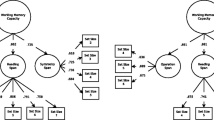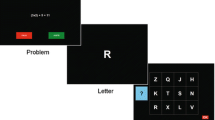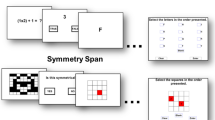Abstract
Three experiments tested whether a modified version of the Clustered Conceptual Span task (H. J. Haarmann, E. J. Davelaar, & M. Usher, 2003), which ostensibly requires active maintenance of semantic representations, predicted individual differences in higher-order cognitive abilities better than short-term memory (STM) span tasks or nonsemantic versions of the“Conceptual” task did. Nonsemantic Conceptual tasks presented short word lists clustered by color, first letter, or initial vowel sound, and cued subjects to recall only 1 of 3 clusters from each list; the Semantic task clustered words by taxonomic category. The Semantic Conceptual task generally failed to predict incremental variance in either verbal abilities or general fluid intelligence beyond the other Conceptual tasks or STM span tasks. Although the Semantic task showed a stronger relation to working memory span tasks than did the nonsemantic tasks (Experiment 3), that stronger relation did not translate into strong prediction of cognitive individual differences.
Similar content being viewed by others
References
Baddeley, A. D., Gathercole, S., &Papagno, C. (1998). The phonological loop as a language learning device.Psychological Review,105, 158–173.
Baddeley, A. D., Lewis, V. J., &Vallar, G. (1984). Exploring the articulatory loop.Quarterly Journal of Experimental Psychology,36, 233–252.
Barrouillet, P., Bernadin, S., &Camos, V. (2004). Time constraints and resource sharing in adults’ working memory spans.Journal of Experimental Psychology: General,133, 83–100.
Battig, W. F., &Montague, W. E. (1969). Category norms for verbal items in 56 categories: A replication and extension of the Connecticut category norms.Journal of Experimental Psychology,80, 1–46.
Berger, F. R., Gupta, W. B., Berger, R. M., &Skinner, J. (1990).Air Force Officer Qualifying Test (AFOQT) form P: Test manual (AFHRLTR-89-56). Brooks Air Force Base, TX: Manpower and Personnel Division, Air Force Human Resources Laboratory.
Bousfield, A. K., &Bousfield, W. A. (1966). Measurement of clustering and of sequential constancies in repeated free recall.Psychological Reports,19, 935–942.
Bunting, M. F. (2006). Proactive interference and item similarity in working memory.Journal of Experimental Psychology: Learning, Memory, & Cognition,32, 183–196.
Burgess, N., &Hitch, G. J. (1999). Memory for serial order: A network model of the phonological loop and its timing.Psychological Review,106, 551–581.
Cantor, J., Engle, R. W., &Hamilton, G. (1991). Short-term memory, working memory, and verbal abilities: How do they relate?Intelligence,15, 229–246.
Cohen, R. L., &Sandberg, T. (1977). Relation between intelligence and short-term memory.Cognitive Psychology,9, 534–554.
Cohen, R. L., &Sandberg, T. (1980). Intelligence and short-term memory: A clandestine relationship.Intelligence,4, 319–331.
Coltheart, M. (1981).Unpublished MRC database user manual: Version 1.
Conway, A. R. A., Cowan, N., Bunting, M. F., Therriault, D., &Minkoff, S. (2002). A latent variable analysis of working memory capacity, short term memory capacity, processing speed, and general fluid intelligence.Intelligence,30, 163–183.
Conway, A. R. A., Kane, M. J., Bunting, M. F., Hambrick, D. Z., Wilhelm, O., &Engle, R. W. (2005). Working memory span tasks: A methodological review and user’s guide.Psychonomic Bulletin & Review,12, 769–786.
Cowan, N. (2005).Working memory capacity. New York: Psychology Press.
Crosson, B., Rao, S. M., Woodley, S. J., Rosen, A. C., Bobholz, J. A., Mayer, A., et al. (1999). Mapping of semantic, phonological, and orthographic verbal working memory in normal adults with functional magnetic resonance imaging.Neuropsychology,13, 171–187.
Daneman, M., &Merikle, P. M. (1996). Working memory and language comprehension: A meta-analysis.Psychonomic Bulletin & Review,3, 422–433.
Dempster, F. N. (1981). Memory span: Sources of individual and developmental differences.Psychological Bulletin,89, 63–100.
Ekstrom, R. B., French, J. W., Harman, M. H., &Dermen, D. (1976).Manual for kit of factor-referenced cognitive tests. Princeton, NJ: Educational Testing Service.
Engle, R. W., &Kane, M. J. (2004). Executive attention, working memory capacity, and a two-factor theory of cognitive control. In B. H. Ross (Ed.)The psychology of learning and motivation (Vol. 44, pp. 145–199). New York: Academic Press.
Engle, R. W., Nations, J. K., &Cantor, J. (1990). Is “working memory capacity” just another name for word knowledge?Journal of Educational Psychology,82, 799–804.
Engle, R. W., Tuholski, S. W., Laughlin, J. E., &Conway, A. R. A. (1999). Working memory, short-term memory and general fluid intelligence: A latent variable approach.Journal of Experimental Psychology: General,128, 309–331.
Farrell, S., &Lewandowsky, S. (2002). An endogenous distributed model of ordering in serial recall.Psychonomic Bulletin & Review,9, 59–79.
Haarmann, H. J., Ashling, G. E., Davelaar, E. J., &Usher, M. (2005). Age-related declines in context maintenance and semantic short-term memory.Quarterly Journal of Experimental Psychology,58A, 34–53.
Haarmann, H. J., Davelaar, E. J., &Usher, M. (2003). Individual differences in semantic short-term memory capacity and reading comprehension.Journal of Memory & Language,48, 320–345.
Haarmann, H. J., &Usher, M. (2001). Maintenance of semantic information in capacity-limited item short-term memory.Psychonomic Bulletin & Review,8, 568–578.
Hambleton, R. K., Swaminathan, H., &Rogers, J. H. (1991).Fundamentals of item response theory. New York: Sage.
Hanten, G., &Martin, R. C. (2000). Contributions of phonological and semantic short-term memory to sentence processing: Evidence from two cases of closed-head injury in children.Journal of Memory & Language,43, 355–361.
Henson, R. N. A. (1998). Short-term memory for serial order: The start-end model.Cognitive Psychology,36, 73–137.
Horn, J. L., Donaldson, G., &Engstrom, R. (1981). Apprehension, memory, and fluid intelligence decline in adulthood.Research on Aging,3, 33–84.
Jacobs, J. (1887). Experiments on “prehension.”Mind,12, 75–79.
Kane, M. J., Hambrick, D. Z., &Conway, A. R. A. (2005). Working memory capacity and fluid intelligence are strongly related constructs: Comment on Ackerman, Beier, and Boyle (2005).Psychological Bulletin,131, 66–71.
Kane, M. J., Hambrick, D. Z., Tuholski, S. W., Wilhelm, O., Payne, T. W., &Engle, R. W. (2004). The generality of working memory capacity: A latent-variable approach to verbal and visuospatial memory span and reasoning.Journal of Experimental Psychology: General,133, 189–217.
Kellogg, C. E., &Morton, N. W. (1999).Revised Beta Examination— Third edition. San Antonio, TX: Psychological Corporation.
Kline, R. B. (2004).Principles and practice of structural equation modeling (2nd ed.). New York: Guilford Press.
La Pointe, L. B., &Engle, R. W. (1990). Simple and complex word spans as measures of working memory capacity.Journal of Experimental Psychology: Learning, Memory, & Cognition,16, 1118–1133.
Lustig, C., May, C. P., &Hasher, L. (2001). Working memory span and the role of proactive interference.Journal of Experimental Psychology: General,130, 199–207.
Mandler, G. (1968). Organized recall: Individual functions.Psychonomic Science,13, 230–236.
Martin, R. C., &Freedman, M. (2001). Verbal working memory: The ins and outs of phonological and lexical-semantic retention. In H. L. Roediger III, J. S. Nairne, I. Neath, & A. M. Surprenant (Eds.),The nature of remembering: Essays in honor of Robert G. Crowder (pp. 331–349). Washington, DC: American Psychological Association.
Martin, R. C., &Romani, C. (1994). Verbal working memory and sentence comprehension: A multiple-components view.Neuropsychology,9, 506–523.
Neath, I., &Nairne, J. S. (1995). Word-length effects in immediate memory: Overwriting trace decay theory.Psychonomic Bulletin & Review,2, 429–441.
Oberauer, K. (2005). The measurement of working memory capacity. In O. Wilhelm & R. W. Engle (Eds.),Handbook of understanding and measuring intelligence (pp. 393–407). Thousand Oaks, CA: Sage.
Oberauer, K., Schulze, R., Wilhelm, O., &Süss, H.-M. (2005). Working memory and intelligence—their correlation and their relation: Comment on Ackerman, Beier, and Boyle (2005).Psychological Bulletin,131, 61–65.
Page, M. P. A., &Norris, D. (1998). The primacy model: A new model of immediate serial recall.Psychological Review,105, 761–781.
Psychological Corporation (1999).Wechsler Abbreviated Scale of Intelligence. San Antonio, TX: Psychological Corporation.
Raven, J. C., Raven, J. E., &Court, J. H. (1998).Progressive matrices. Oxford: Oxford Psychologists Press.
Saito, S. (2006, July).Forgetting and interference in working memory span tests. Paper presented at the 4th International Conference on Memory, Sydney, Australia.
Swanson, H. L. (1992). Generality and modifiability of working memory among skilled and less skilled readers.Journal of Educational Psychology,84, 473–488.
Tehan, G., &Lalor, D. M. (2000). Individual differences in memory span: The contribution of rehearsal, access to lexical memory, and output speed.Quarterly Journal of Experimental Psychology,53A, 1012–1038.
Turner, M. L., &Engle, R. W. (1989). Is working memory capacity task dependent?Journal of Memory & Language,28, 127–154.
Author information
Authors and Affiliations
Corresponding author
Rights and permissions
About this article
Cite this article
Kane, M.J., Miyake, T.M. The validity of “conceptual span” as a measure of working memory capacity. Memory & Cognition 35, 1136–1150 (2007). https://doi.org/10.3758/BF03193484
Received:
Accepted:
Published:
Issue Date:
DOI: https://doi.org/10.3758/BF03193484




